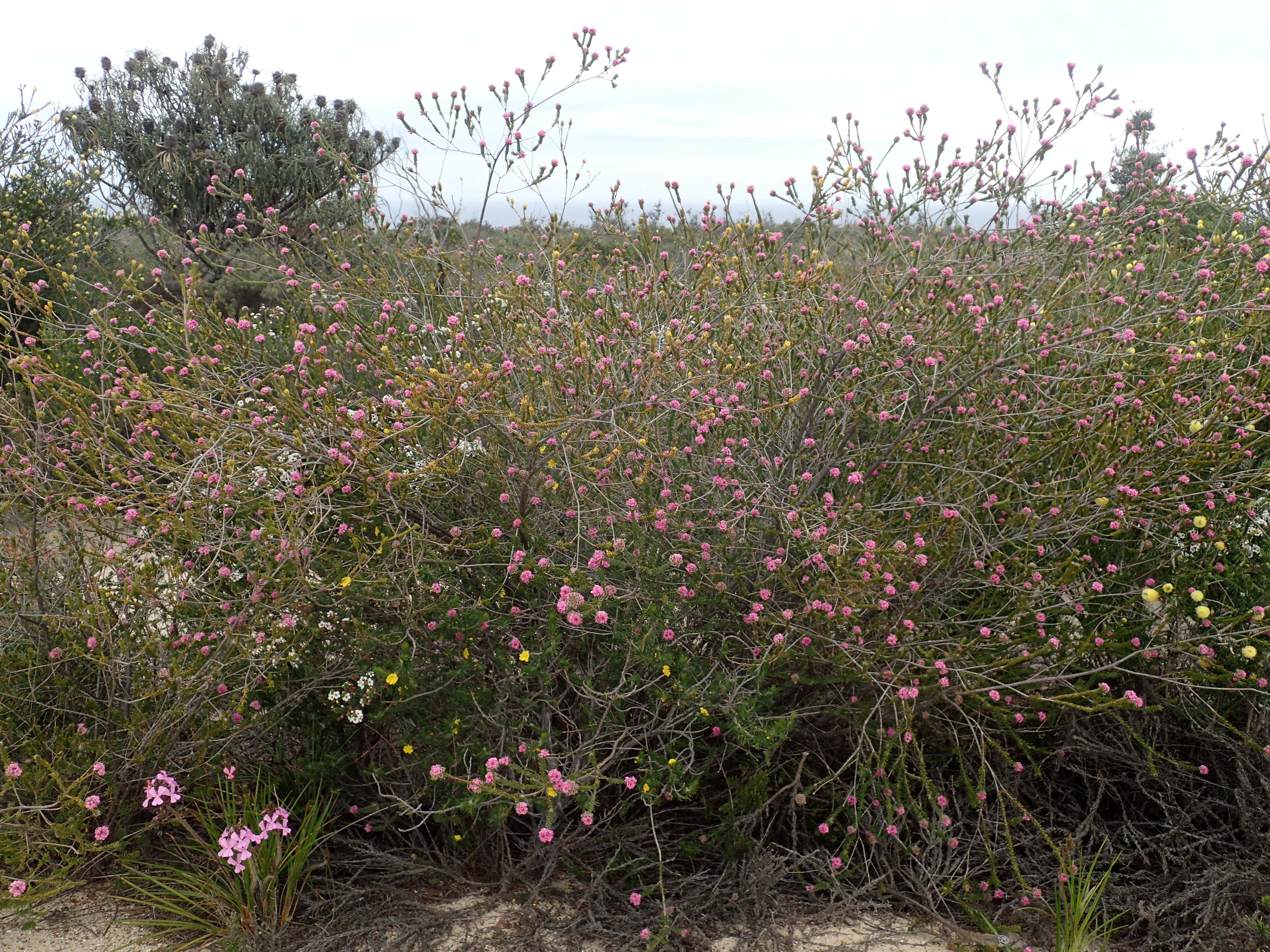Kunzea Similis on:
[Wikipedia]
[Google]
[Amazon]
''Kunzea similis'' is a species of flowering plant in the myrtle family, 
Myrtaceae
Myrtaceae, the myrtle family, is a family of dicotyledonous plants placed within the order Myrtales. Myrtle, pōhutukawa, bay rum tree, clove, guava, acca (feijoa), allspice, and eucalyptus are some notable members of this group. All speci ...
and is endemic to a small area along the south coast of Western Australia. It is a shrub with linear to lance-shaped leaves with a single vein, and spherical groups of between four and ten pink flowers on the ends of shoots.
Description
''Kunzea similis'' is an erect shrub that typically grows to a height of and has several main stems with few branches. Young branches are densely covered with silky hairs. The leaves are linear to lance-shaped with the narrower end towards the base, long and long on a petiole about long. It differs from '' K. capitata'' in having leaves with a single vein. The flowers are arranged in more or less spherical groups of between four and ten flowers on the ends of the shoots. There are lance-shaped to egg-shapedbract
In botany, a bract is a modified or specialized leaf, especially one associated with a reproductive structure such as a flower, inflorescence axis or cone scale. Bracts are usually different from foliage leaves. They may be smaller, larger, or of ...
s and pairs of bracteoles at the base of the flowers. The sepals are triangular, long and densely covered with silky hairs. The petal
Petals are modified Leaf, leaves that surround the reproductive parts of flowers. They are often advertising coloration, brightly colored or unusually shaped to attract pollinators. All of the petals of a flower are collectively known as the ''c ...
s are pink, spatula-shaped to egg-shaped with the narrower end towards the base and long. There are between 32 and 44 stamen
The stamen (plural ''stamina'' or ''stamens'') is the pollen-producing reproductive organ of a flower. Collectively the stamens form the androecium., p. 10
Morphology and terminology
A stamen typically consists of a stalk called the filame ...
s that are long. Flowering occurs from September to November and the fruit is an urn-shaped capsule.
Taxonomy and naming
''Kunzea similis'' was first formally described in 1996 by Hellmut R. Toelken and the description was published in '' Journal of the Adelaide Botanic Garden''. Thespecific epithet
In taxonomy, binomial nomenclature ("two-term naming system"), also called nomenclature ("two-name naming system") or binary nomenclature, is a formal system of naming species of living things by giving each a name composed of two parts, bot ...
(''similis'') is a Latin word meaning "like".
Two subspecies
In biological classification, subspecies is a rank below species, used for populations that live in different areas and vary in size, shape, or other physical characteristics (morphology), but that can successfully interbreed. Not all species ...
were described in 2007 by Toelken and Gillian Craig and are accepted by the Australian Plant Census:
* ''Kunzea similis'' subsp. ''mediterranea'' Toelken & G.F.Craig, a shrub that grows to a height of and has bracteoles that are longer than those of the autonym;
* ''Kunzea similis'' Toelken subsp. ''similis'', a smaller shrub with bracteoles that are hidden between the flowers.
Distribution and habitat
Subspecies ''similis'' occurs in the Fitzgerald River National Park near Hopetoun, where it grows in sparse, low heath. Subspecies ''mediterranea'' is found in a small area to the east ofRavensthorpe Ravensthorpe may refer to any of the following places.
England
*Ravensthorpe, Dewsbury in West Yorkshire
**Ravensthorpe railway station, Dewsbury
*Ravensthorpe, Northamptonshire
*Ravensthorpe, Peterborough in Cambridgeshire
*Ravensthorpe, an histor ...
growing on a ridge top in open mallee and dense heath.
Conservation status
Both subspecies of ''K. similis'' are classified as " Threatened Flora (Declared Rare Flora — Extant)" by the Department of Environment and Conservation (Western Australia). Subspecies ''similis'' is listed as "critically endangered" under the Australian Government '' Environment Protection and Biodiversity Conservation Act 1999''. The main threat to the subspecies is the fungal disease caused by '' Phytophthora cinnamomi''.References
{{Taxonbar, from=Q15368896 similis Endemic flora of Southwest Australia Myrtales of Australia Rosids of Western Australia Plants described in 1996 Taxa named by Hellmut R. Toelken